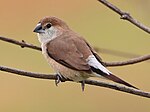Coccidia (Coccidiasina) are a subclass of microscopic, spore-forming, single-celled obligate intracellular parasites belonging to the apicomplexan class...
9 KB (883 words) - 19:07, 17 June 2024
Coccidiosis (section Coccidia in dogs)
animals infected with coccidia are asymptomatic, but young or immunocompromised animals may suffer severe symptoms and death. While coccidia can infect a wide...
10 KB (1,187 words) - 05:40, 15 December 2023
Apicomplexa, Cyclospora belong to the sub-class Coccidia and family Eimeriidae. Taxonomy of the coccidia is based upon morphological descriptions of observed...
4 KB (370 words) - 19:01, 25 February 2024
infection is coccidiosis caused by a protozoa (one-celled organisms) called coccidia. Cystoisospora, previously known Isospora, is a genus that causes coccidiosis...
8 KB (930 words) - 01:20, 12 October 2022
The Apicomplexa are a diverse group that includes organisms such as the coccidia, gregarines, piroplasms, haemogregarines, and plasmodia. Diseases caused...
46 KB (4,906 words) - 12:05, 30 October 2024
treatment of equine protozoal myeloencephalitis (EPM) in horses, caused by coccidia Sarcocystis neurona. Veterinarians have been preparing a formulary version...
4 KB (241 words) - 07:09, 23 October 2024
A coccidiostat is an antiprotozoal agent that acts upon Coccidia parasites. Examples include: Amprolium Arprinocid Artemether Clazuril Clopidol Decoquinate...
1 KB (90 words) - 22:45, 21 January 2024
treat coccidiosis in animals. Coccidiosis is a parasitic disease caused by coccidia, which are microscopic, spore-forming, single-celled obligate intracellular...
5 KB (341 words) - 05:48, 23 September 2024
partly understood. Two major clades have been identified: the isosporoid coccidia (Toxoplasma, Neospora, Isospora [in part], and Sarcocystis) and a second...
5 KB (386 words) - 00:17, 21 October 2022
protozoan Coccidia (from the Greek kokkis, "little berry"). In 1896, Gilchrist and Rixford named the organism Coccidioides ("resembling Coccidia") immitis...
6 KB (518 words) - 13:29, 26 April 2024
Calicivirus Congenital sensorineural deafness Feline corneal sequestrum Flea Coccidia Heartworm Hepatic lipidosis Hypertrophic cardiomyopathy Immunodeficiency...
161 KB (16,535 words) - 04:58, 2 November 2024
class was defined in 1988 by Levine and contains two subclasses – the coccidia and the gregarines. All members of this class have a complete, hollow,...
2 KB (192 words) - 02:16, 23 February 2023
only a single host species, such as gregarines) or not (e.g. Eimeria, Coccidia). Odening, Klaus (1976-01-20). "Conception and terminology of hosts in...
2 KB (174 words) - 18:01, 22 November 2020
off coccidia, common bacteria responsible for an average of a 20% death rate of poultry. New studies in Ohio have shown death rates from coccidia as low...
12 KB (1,733 words) - 19:30, 12 November 2023
November 2024 (link) "Coccidia Parasite Life Cycle". Retrieved 12 May 2014. Julius P Kreir, ed. (1977). Gregarines, Haemogregarines, Coccidia, Plasmodia, and...
41 KB (4,452 words) - 14:24, 2 November 2024
parasites are lice, fleas, fly larvae, ticks, mites, cestodes, nematodes, and coccidia. Taenia is a notable genus with 5 species in which dogs are the definitive...
186 KB (17,538 words) - 06:20, 2 November 2024
(such as Taenia serialis), external parasites (including fleas and mites), coccidia species, Encephalitozoon cuniculi, and Toxoplasma gondii. Domesticated...
122 KB (12,692 words) - 23:02, 3 November 2024
Isospora is a genus of internal parasites in the subclass Coccidia. It is responsible for the condition isosporiasis, which causes acute, non-bloody diarrhoea...
4 KB (272 words) - 00:36, 7 May 2021
Isospora sylviae is a species of internal parasite classified under Coccidia. It frequently occurs in the Eurasian blackcap and the garden warbler. Chapter...
1 KB (71 words) - 16:08, 30 July 2024
Isospora ashmoonensis is a species of internal parasites classified under Coccidia. It was first identified in a blackcap in Egypt. Mohamad, A A (December...
829 bytes (52 words) - 16:26, 15 April 2024
Leishmania, which causes leishmaniasis. Chameleons are subject to parasitism by coccidia, including species of the genera Choleoeimeria, Eimeria, and Isospora....
60 KB (6,280 words) - 13:37, 28 October 2024
Calicivirus Congenital sensorineural deafness Feline corneal sequestrum Flea Coccidia Heartworm Hepatic lipidosis Hypertrophic cardiomyopathy Immunodeficiency...
27 KB (3,125 words) - 15:28, 2 November 2024
celled character and belongs to the family Sarcocystidae, in a group called coccidia. The protozoan, S. neurona, is a member of the genus Sarcocystis, and is...
13 KB (1,642 words) - 06:20, 26 August 2024
2011.10.022. Fayner R (1980). "Epidemiology of protozoan infections: the coccidia". Veterinary Parasitology. 6 (1–3): 75–103. doi:10.1016/0304-4017(80)90039-4...
36 KB (3,724 words) - 17:32, 1 November 2024
sporozoites are ready to be released. As it stands there are some piscine coccidia which lack Stiedal bodies and are part of other related genera. These will...
19 KB (2,255 words) - 18:26, 20 January 2024
Borrelia and thus can potentially disperse Lyme disease over a wide region. Coccidia such as Isospora sp. are known in this species. The common cuckoo is sometimes...
15 KB (1,512 words) - 14:00, 11 October 2024
amoebozoans, roundworms, trematodes and tapeworms. Roundworms, tapeworms and coccidia were also found in red panda scat collected in Rara and Langtang National...
87 KB (9,477 words) - 06:26, 8 September 2024
1654/1525-2647-88.1.7. S2CID 233914359. Lainson, Ralph; Shaw, Jeffrey J. (1982). "Coccidia of Brazilian edentates: Eimeria cyclopei n.sp. from the silky anteater...
39 KB (4,538 words) - 21:37, 27 May 2024
a pair are sometimes seen at a nest. Several parasitic protozoans and coccidia (Sivatoshella lonchurae) have been described from the species. Foraging...
13 KB (1,284 words) - 08:47, 1 July 2024























